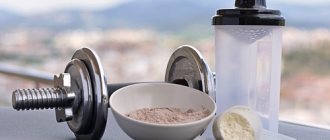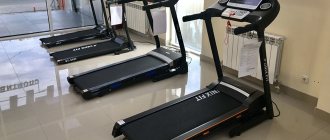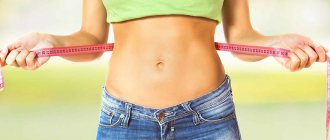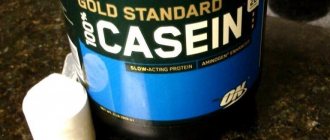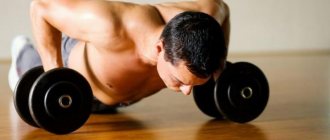Published 08/16/2019 · Comments: · Reading time: 8 min · Views: Post Views: 3,844
Flexible dieting is the invention of the famous sports physiologist and bore, in a positive sense, Lyle MacDonald! Its concept is simple - eat whatever you want, only within your calorie limits. Western practitioners even came up with the acronym IIFYM - If It Fits Your Macros. This phrase is usually used to answer questions like: “Can I eat a banana or cake or ice cream on a diet?” It translates as: “If it fits into your macro, that is, your daily caloric intake.”
Today I will share my thoughts on why IIFYM is no longer an effective tool.
What should be the correct diet?
There are a huge number of different diets in the world. The main principle by which absolutely any diet without exception works is to force the person losing weight to expend more energy than they consume in food. When you go on another diet that requires you to give up certain foods, you simply reduce the caloric content of your diet, and nothing more. Therefore, the main thing you need for effective fat burning is to create a calorie deficit , and what foods you eat plays a secondary role.
The second important requirement for any weight loss diet, according to Lyle MacDonald, is to consume enough protein . After all, it is he who best satisfies and satisfies hunger. Diets high in protein help preserve lean muscle mass and maintain stable blood glucose levels over the long term. This helps you stay full and energetic longer.
The nutritionist recommends including low-fat sources of protein in your weight loss diet: chicken breast, fish, lean meat, dairy products. The specialist is confident that sufficient protein intake covers the body's needs for BCAA and other amino acids. Therefore, those who consume protein in sufficient quantities do not need supplements.
Another important requirement for a fat-burning diet is that it must include a large amount of fiber , which also gives you a feeling of fullness for a long time. Fiber is best obtained from vegetables, as they contain many fewer calories than fruits.
Also, the diet should include a moderate amount of fat . Low-fat diets tend to be unpalatable and unnutritious. The diet should contain essential fatty acids, mainly Omega-3. Its source may be fish oil capsules.
As you can see, even on a flexible diet, nutrition should be balanced. Therefore, some people mistakenly think that the flexible dieting is when you can eat one solid junk food and just fit into your macros.
General provisions
Essentially, the Ultimate Diet 2.0 is a carbohydrate cycling diet, however, this diet is strictly dependent on training. The workouts themselves also differ from each other - some are aimed at depleting glycogen, while others are aimed at maintaining and even growing muscle mass. Each type of training is performed strictly according to the schedule on its own day, all manipulations with nutrition and training are performed within the framework of a microcycle, which is 7 days. On days off from strength training, Lyle recommends doing cardio. In a more rigorous version of the Ultimate Diet 2.0, cardio training is performed almost daily.
If it fits your macros
- having a “free” meal from time to time , during which you can eat any food in any quantity . The main point is to allow yourself what you have long wanted and give yourself psychological relief. This helps you get rid of the feeling that you will never be able to eat a certain food again and stick to your diet longer. At the same time, the nutritionist warns that “free” eating should not turn into uncontrolled overeating.
- structured refeed during a diet, lasting from 5 hours to a whole day. This means that during this period of time you may consume more carbohydrates than usual. Refeed is needed not only for psychological relief, but also to preserve muscle mass. You can arrange carbohydrate days approximately once every 7-10 days.
- During any diet, Lyle MacDonald advises taking a break . At the same time, it is very important to maintain weight and not return to old eating habits. A break in the diet is important not only for psychological relief, but also because any body sooner or later adapts to the diet and stops losing weight . During a break in the diet, the nutritionist advises you to go on a maintenance caloric intake, which will allow you to maintain the results achieved.
Break
- According to Lyle MacDonald, when losing weight, it is important to eat foods that keep you full for a long time . A meal consisting of a large amount of carbohydrates first sharply increases the level of glucose, and then just as sharply brings it down. In turn, moderate amounts of protein and fat help you stay full longer. This is why it is so important to balance your diet with macronutrients while losing weight, and not because fast carbohydrates, as some people mistakenly believe, go into fat.
- The nutritionist advises eating approximately 4-5 times a day in equal portions . Moreover, each meal should include proteins, fats, carbohydrates and fiber. This type of nutrition will help you avoid severe hunger and avoid overeating in the future. However, he recognizes that not all people can afford to eat often, so you can eat as many times as you are comfortable with . This will not affect the result in any way.
Training component of the complex
As we already know, training throughout the microcycle will differ quite greatly from each other, both in execution technique and in the effect on the athlete’s body.
So, it is supposed to perform two glycogen-depleting workouts, one “pulling” and one for power, and all workouts are carried out in the full-body style, that is, the entire body is worked out during the workout.
The name glycogen-depleting training speaks for itself - this is a type of training that is aimed at significantly depleting glycogen stores in the body. The main goal of such training is to achieve a burning sensation in the target muscle, which means that the process of glycolysis is in full swing. To achieve this, you need to follow the following rules: the muscles should be under load for 40-60 seconds, rest between approaches for up to one minute, the pace of the exercises should be slow “within the amplitude”, that is, the athlete should not work at full amplitude and fully straighten the limbs. All this should lead to acidification in the target muscle group. You won’t be able to work with heavy weights in this mode; you should take weights with which you can perform about 20 repetitions, but you will work with them in several sets of 15 repetitions.
In the form of a diagram, such a workout (for example, on Monday) would look like this:
| Exercise | Approaches | Repetitions | Rest, min |
| Leg press | 3 | 15 | 1 |
| Lying leg curls | 3 | 15 | 1 |
| Bench press | 3 | 15 | 1 |
| Bent-over barbell row | 3 | 15 | 1 |
| Seated dumbbell press | 3 | 15 | 1 |
| Barbell curl | 2 | 15 | 1 |
| Arm extensions in block | 2 | 15 | 1 |
| Standing calf raises | 3 | 15 | 1 |
The second (Tuesday) glycogen depletion workout can be slightly modified:
| Exercise | Approaches | Repetitions | Rest, min |
| Leg press | 3 | 15 | 1 |
| Lying leg curls | 3 | 15 | 1 |
| Incline Dumbbell Press | 3 | 15 | 1 |
| Lat pulldown/pull-ups | 3 | 15 | 1 |
| Standing dumbbell flyes | 3 | 15 | 1 |
| Dumbbell curls for biceps | 2 | 15 | 1 |
| French press | 2 | 15 | 1 |
| Seated calf raises | 3 | 15 | 1 |
Glycogen-depleting workouts occur on Monday and Tuesday. It is necessary to complete 2 rounds of this training complex. You start with the leg press and perform all the exercises until the last one - raising your toes. Rest for 10-15 minutes and do everything again. Such training will take a lot of time.
On Wednesday, it is expected that the athlete will take a complete rest from strength training and, if possible, perform a cardio workout lasting 30-60 minutes.
On Thursday, the so-called tension training is carried out. The main conditions for such training: solid weights, full range of motion, rest pauses between sets of 2-3 minutes, normal exercise tempo. In no case should you go to failure - always leave 1-2 repetitions in reserve.
| Exercise | Approaches | Repetitions | Rest, min |
| Leg press | 2 | 8-10 | 2-3 |
| Lying leg curls | 2 | 8-10 | 2-3 |
| Seated leg extensions | 2 | 8-10 | 2-3 |
| Standing calf raises | 3-4 | 8-10 | 2-3 |
| Bench press | 2 | 8-10 | 2-3 |
| Bent-over barbell row | 2 | 8-10 | 2-3 |
| Incline Dumbbell Press | 2 | 8-10 | 2-3 |
| Lower block thrust | 2 | 8-10 | 2-3 |
| Standing dumbbell flyes | 2-3 | 10 | 2-3 |
| Crunches | 3 | 12 | 1-2 |
On Friday we will again take a break from strength training and do cardio, and on Saturday we will have a power workout. It serves to maintain or even increase strength indicators. In this workout we use heavy weights for 3-6 reps in 2-3 sets, and rest for 5 minutes in between. The pace of the exercises is explosive.
| Exercise | Approaches | Repetitions | Rest, min |
| Squats | 3 | 3-6 | 5 |
| Bench press | 2-3 | 3-6 | 5 |
| Bent-over barbell row | 3 | 6 | 5 |
| Incline Barbell Press | 2 | 6 | 5 |
| Pull-ups | 3 | 6 | 5 |
| Seated dumbbell press | 2-3 | 3-6 | 5 |
| Barbell curls | 2-3 | 6 | 5 |
| Close grip press | 2-3 | 6 | 5 |
On Sunday we rest, and on Monday we begin the microcycle again.
Pros and cons of flexible dieting
Flexible dieting has many benefits:
- You can choose any foods you like for your diet.
- You strictly control the amount of kbju in your diet, and therefore you are sure that you are giving your body everything it needs.
- You can sit on such a diet for a very long time and not experience moral stress.
- You have no restrictions, you do not divide food into “bad” and “good”.
- You don't feel hungry because you consume enough protein and fat.
- You see a stable result.
- You can safely visit people, dine in restaurants, and attend holidays without remorse.
The disadvantages of a flexible diet include:
- Permissiveness, which can lead some people to an eating disorder. Unfortunately, the forbidden fruit is sweet. Not everyone can limit themselves to one piece of chocolate and one cookie. Someone, feeling the taste of sweets in their mouth, loses control over themselves.
- Some foods are truly undesirable for health, for example, fried foods, smoked foods, which are carcinogens, and trans fats. So if you look from the point of view of losing weight, then a flexible diet works, but if you look at its effect on health, then questions remain.
Reviews from those who have lost weight about a flexible diet:
Natalya, 29 years old
I read Lyle MacDonald’s book and learned that it turns out that you can eat anything, the main thing is to fit into the kbzhu. Even carbs in the evening! There is no need to bother with the glycemic index of foods; there is no need to close any carbohydrate window after training.
At first I was afraid to switch to such a diet. Am I going to get fat? But my experience has shown that this all really works. Counting calories is not a chore for me at all. To be slim, I am ready to do this for the rest of my life. The most important thing is that now I can afford any delicious food.
Tamara, 25 years old
A flexible diet is an excellent example of reasonable nutrition, with which a woman maintains her menstrual cycle and good mood. Don't be afraid to include chocolate in your diet. The main thing is to count calories, proteins, fats and carbohydrates. In general, eat everything, be happy and lose weight.
Key Findings
- Flexible dieting is effective over short distances. Then, most often, exhaustion and breakdown occur if you do not choose food responsibly.
- Calorie counting and flexible dieting are only effective in the long term on a very high quality diet.
- Whatever style of eating you follow, the whole refined travesty of food will be the enemy of your progress. It is literally designed to be abused. Therefore, do not be surprised if it is difficult for you to stop until you have devoured all the “delicious” things that are in the house.
If you find an error, please select a piece of text and press Ctrl+Enter.
Post Views: 3,844
Tags: IIFYM, Flexible Dieting, Calories, Lyle McDonald, Nutrition, Food Industry, bliss point
Content
- 1 Lyle MacDonald 1.1 Book List
- 3.1 How we get fat, part 1: More energy is consumed than expended
- 4.1 Training program
- 5.1 Principles of Reverse Dieting
Cover the BZHU norm
When used correctly, a flexible diet offers an excellent balance of stability and flexibility. Determine your daily requirement for nutritional supplements (we'll get to that soon), and take advantage of the freedom to choose from a variety of products to cover this need. After all, you can get calories from anywhere, but you have to look for macronutrients in specific sources.
Build your day around these sources and you'll have room to maneuver when you need it.
Squirrels
Sources of protein. Egg whites, egg yolks, milk, cheese, yogurt, cottage cheese, chicken, turkey, pork, beef, fish, nuts, beans, peas, lentils, soybeans and other legumes.
Biological role. Protein is a combination of amino acids necessary for recovery, muscle growth and regenerative processes throughout the body. But protein isn't just about biceps, it's also about satiation, which is useful for exercisers who want to lose weight or gain muscle mass.
Carbohydrates
Sources of carbohydrates. Oatmeal, rice, bread, cereal, pasta, quinoa, potatoes, fruits, vegetables, chips, cookies, candy.
Biological role. Carbohydrates are the main source of energy. Both muscles and brain prefer this fuel.
There are two types of carbohydrates: simple and complex. Complex carbohydrates are digested slowly, and foods that contain them are usually darker in color. They are full of vitamins and minerals, and due to their high fiber content, they provide a steady flow of energy. Examples include oats, brown rice, starchy vegetables and whole grain bread.
Simple carbohydrates are absorbed very quickly, and the foods that contain them are usually lighter in color. Examples are white rice, white bread, cookies and sweets.
Fats
Sources of fats. Olive oil, canola oil, coconut oil, natural peanut butter and other nut oils, avocado, almonds, walnuts, cashews, red fish, mackerel, egg yolks.
Biological role. Fats are essential nutrients involved in many physiological processes. They play an important role in cellular signaling systems and ensure communication within the body. Fats allow the body to absorb vitamins and help maintain healthy hormonal levels. Not to mention, they're delicious.
Unsaturated fats. They are usually called the “healthiest” fats because they have a positive effect on the cardiovascular system, mental performance and memory.
Saturated fats. They participate in the synthesis of testosterone and optimize the production of other important hormones.
Trans fats. They are often called “harmful” because they negatively damage blood vessels and increase the risk of developing various metabolic disorders.
Do women recover faster?
It is believed that women are able to withstand higher volume training and that they recover better than men, so a women's training program should include more training with shorter rest/recovery periods. What do you think about this?
In terms of faster recovery, this is generally true for a number of reasons, not the least of which is that women have lower strength, power and speed (sprint) scores and therefore less fatigue.
A number of other mechanisms are also involved here, and partly it depends on the load.
With a moderate load, women recover faster both within one workout and within a training cycle. With a killer load, there is no difference (in this case we are talking about a study where 20 sets of 1 repetition were used with 100% of the one-rep maximum).
In addition, there is a difference in performance between the upper and lower body.
In general, it's wildly difficult. Let's say the Chinese women's weightlifting team trains more intensely, harder and more often, but in weightlifting the exercises are performed with submaximal weights (for example, the clean and jerk is done with 80-85% of 1RM in the deadlift, and practicing this exercise with 90% of the RM - the same as 72% - and this is the average weight).
In addition, they are explosive (here women are physically weaker than men) and allow women to use the flexibility of the lower body.
Approximate diet
The essence of the diet is that everyone draws up a “sample menu” themselves, based on weight, taste preferences and goals.
For example, if a girl weighs 60 kg, loves ice cream and pizza and doesn’t do cardio, she can build her menu like this:
- Day 1. Meal 1 – scrambled eggs, bell pepper, bread. Meal 2 – beef, vegetables, bulgur. Meal 3 – a serving of ice cream before training. Meal 4 – chicken, vegetables, buckwheat.
- Day 2. 1st meal - a piece of pizza, 2nd, 3rd and 4th meals - a serving of vegetables and something protein, meat or fish.
Usually, sweet or unhealthy foods are eaten before training to raise blood glucose levels and fully utilize recovery processes.
Important! A flexible diet can be tailored to suit a “passive” lifestyle without training, but it was originally developed for strength athletes and ordinary fitness enthusiasts.
